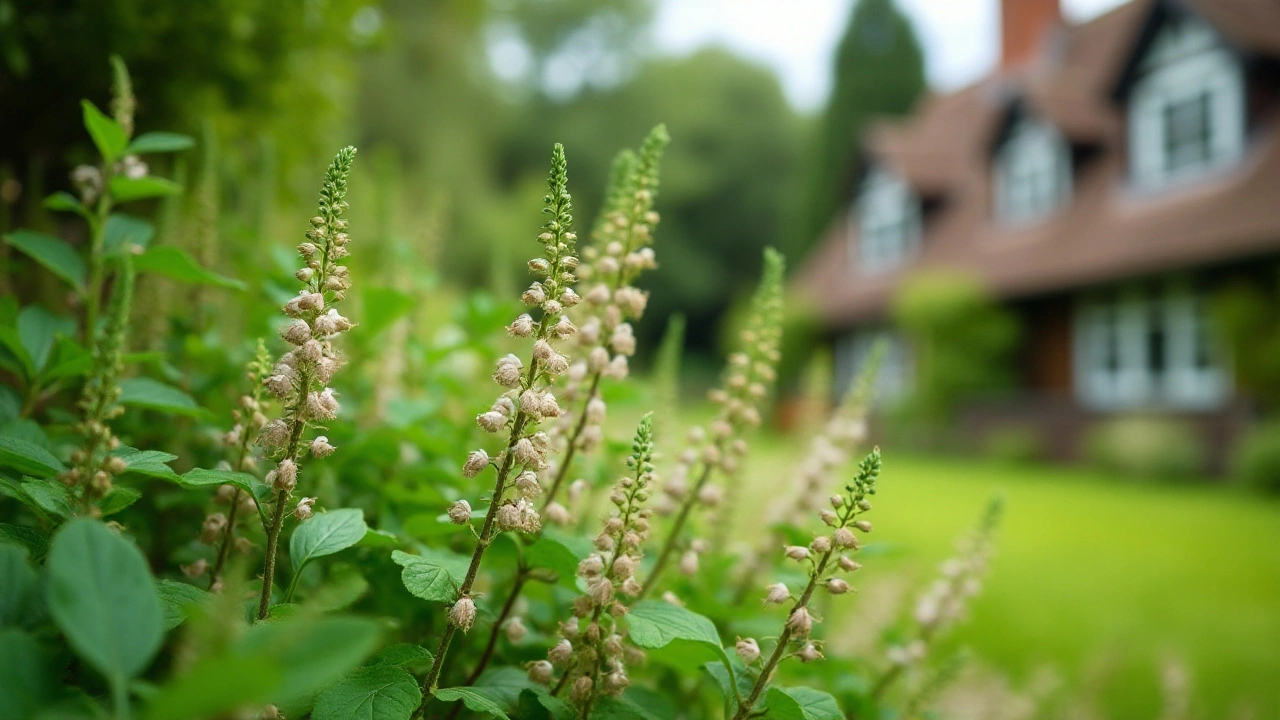
With the surge in popularity of natural remedies, Picrorhiza stands out as an exceptional find in the modern dietary supplement market. This herb, often called the 'liver protector,' is renowned for its potent health benefits and rich history.
For centuries, indigenous cultures have revered Picrorhiza for its healing properties. Now, contemporary science is catching up, revealing its potential as a staple in health and wellness. As interest grows, it's important to understand what makes Picrorhiza so special and how it can fit into a modern lifestyle.
- Introduction to Picrorhiza
- Historical Uses and Origins
- Health Benefits and Scientific Studies
- Current Trends and Market Demand
- How to Integrate Picrorhiza into Your Routine
- Future Prospects and Innovations
Introduction to Picrorhiza
Picrorhiza, also known as Picrorhiza kurroa, is an herb native to the Himalayan region of India, Nepal, and Tibet. This fascinating plant has been used in traditional Ayurvedic medicine for centuries, primarily for liver health and immune support. The plant grows in rocky, cool habitats at high altitudes, making it a resilient herb with a rich array of bioactive compounds.
The primary component that makes Picrorhiza noteworthy is an active compound called picroside. This compound has shown various medicinal properties, including antioxidant, anti-inflammatory, and hepatoprotective (liver-protecting) effects. Due to these qualities, Picrorhiza is often employed to treat liver disorders, respiratory conditions, and gastrointestinal problems. Another component, apocynin, also contributes to the herb’s anti-inflammatory actions.
In ancient Ayurvedic texts, Picrorhiza is revered as a 'Rasayana' herb, meaning it promotes long life and rejuvenation. But it's not just ancient wisdom that supports these claims; modern research has started to back up the historical uses of the herb. A study published in the Journal of Ethnopharmacology found that Picrorhiza extract could significantly lower liver enzyme levels, markers that indicate liver damage. This study showcases the traditional and scientific synergy that makes this herb intriguing.
One of the more compelling aspects of Picrorhiza is its adaptability in formulations. It can be used in powders, capsules, teas, and even integrated into food products. For those interested in natural health solutions, this flexibility means it’s easy to incorporate into your daily routine. Dr. Anil K. Meena, a noted researcher, stated,
"Picrorhiza is an exceptional herb that offers robust benefits for liver and overall health."
Traditional and Modern Uses
In addition to liver health, Picrorhiza has several other traditional uses that are now being explored by modern science. In Ayurveda, it's often used to treat symptoms of asthma, bronchitis, and allergies due to its anti-inflammatory properties. Its potential in treating these conditions is also supported by research, showing it can reduce airway inflammation.
The herb is also used for digestive issues, such as indigestion and constipation. Its bitter principles help stimulate digestive enzymes, making it a valuable addition to digestive health regimes. Given its broad range of applications, it’s not surprising that Picrorhiza is gaining traction in the Western world as a go-to supplement for various health concerns.
Potential Benefits and Scientific Studies
A range of studies have been conducted to explore the benefits of Picrorhiza. It’s been shown to have potent antioxidant properties, which help protect cells from damage. Antioxidants are crucial for reducing oxidative stress, a factor in many chronic diseases. Another study from the National Library of Medicine found that Picrorhiza could enhance the immune response, making it a candidate for supporting overall immunity.
In summary, Picrorhiza is not just a plant but a powerhouse of benefits, supported by both traditional use and modern science. Whether you are looking for liver support, digestive aid, or immune enhancement, Picrorhiza offers a promising natural option that's easy to incorporate into daily life. As research continues to uncover more about this versatile herb, its role in the dietary supplement industry is set to expand, redefining how we approach natural health solutions.
Historical Uses and Origins
Picrorhiza, a name not readily found on the lips of your everyday person, has been a vital component in traditional medicine for centuries. Known as 'Kutki' in Ayurvedic traditions, this herb grows plentifully in the Himalayan regions, thriving in the cool, moist climate. Ancient Ayurvedic texts extol the virtues of Picrorhiza, highlighting its key role in detoxifying the liver, improving digestion, and bolstering the body’s defenses against various ailments.
The origins of Picrorhiza usage can be traced back over a millennia, where it first found fame in the rich tapestry of Indian medicine. Sushruta Samhita, an ancient Sanskrit text on medicine and surgery, often referred to Picrorhiza for its potent therapeutic properties. Its use wasn’t just confined to India. Tibetan healers have historically incorporated this powerhouse herb into their treatments, particularly for respiratory issues and liver ailments. During a time when synthetic drugs were non-existent, Picrorhiza was a cornerstone for maintaining health and treating diseases
In the late 19th century, Picrorhiza caught the attention of Western herbalists, who began considering it a possible ally in the fight against liver diseases. British colonizers learned about the herb from local practitioners in India, and carried this knowledge back to Europe. The initial adoption was slow, yet persistent interest in herbal medicine facilitated its spread. By the mid-20th century, it had cemented its place in the Western herbal pharmacopeia.
Noted herbalist James A. Duke remarked, "When it comes to liver health, few can rival the prowess of Picrorhiza. This herb has held its ground for centuries, a testament to its potent and consistent efficacy."The herb's ability to adapt to the changing landscape of medicine speaks volumes about its reliability and benefits.
Beyond medicinal uses, tribal communities trusted Picrorhiza's detoxifying traits, consuming small portions regularly to ward off seasonal illnesses. They often combined it with other local herbs to maximize its benefits, showcasing an intimate understanding of natural remedies. Contemporary uses barely scrape the surface of what this herb has been employed for in historical contexts, demonstrating a legacy of holistic health management.
The Transition to Modern-Day Medicine
The turn of the 21st century saw a renewed fascination with Picrorhiza, spurred by emerging scientific studies that sought to validate traditional claims. Researchers started diving deep, finding that the herb boasts an impressive arsenal of compounds such as picrosides and kutkosides, which directly support liver function and immunity. Reinforced by modern science, the historical skepticism surrounding herbal treatments began to wane, leading to a surge in Picrorhiza's popularity.This historical journey of Picrorhiza from the fringes of the Himalayas to the shelves of health stores worldwide showcases not only its staying power but also the timeless recognition of its benefits. As modern dietary supplements gain momentum, Picrorhiza continues to bridge the gap between traditional wisdom and contemporary health solutions, promising a fusion of ancient and modern approaches to well-being.

Health Benefits and Scientific Studies
Picrorhiza has garnered significant attention for its diverse health benefits, grounded in both traditional uses and contemporary research. Often highlighted for its liver-protective properties, Picrorhiza has been a staple in Ayurvedic practices for centuries. Modern science has corroborated many of these benefits, bringing the herb into the spotlight.
One of the most documented benefits of Picrorhiza is its role in liver health. It contains active compounds, such as picroside I and picroside II, which have been shown to protect liver cells from damage. Research published in the Journal of Ethnopharmacology has indicated that these compounds can inhibit the peroxidation of lipids in liver cells, a key factor in liver disease.
Another area where Picrorhiza shows promise is in its anti-inflammatory properties. Studies have demonstrated that the herb can reduce inflammation in conditions like asthma and arthritis. Scientists believe this is due to its ability to modulate the immune response. Interestingly, a study in the International Immunopharmacology journal found that Picrorhiza extracts significantly decreased inflammatory markers in test subjects.
Beyond these primary benefits, Picrorhiza has shown potential in boosting the immune system. In one notable study, participants who consumed the herb showed an increased production of certain white blood cells, crucial for fighting off infections. This aligns with traditional uses of the herb in treating colds and respiratory infections.
Researchers are also exploring Picrorhiza's antioxidant capabilities. Antioxidants are essential for neutralizing free radicals, which are responsible for cellular damage and aging. A study from the University of Sydney found that Picrorhiza extract possesses strong antioxidant properties, comparable to well-known antioxidants like Vitamin C.
While most of the research has been conducted in lab settings, clinical trials are on the rise. One noteworthy clinical trial conducted in India observed significant improvement in liver function tests among patients with chronic liver disease who were administered Picrorhiza supplements. Such findings are promising and suggest that Picrorhiza could play a valuable role in conventional medicine.
"Picrorhiza offers a unique blend of traditional wisdom and modern scientific validation, making it a potent ally in the pursuit of health," says Dr. Samuel Harris, a leading researcher in herbal medicine.
As more scientific studies are undertaken, the potential applications of Picrorhiza continue to expand. With ongoing research, it may soon become a common recommendation not just for liver health, but for general wellness. Its natural origins and minimal side effects make it an attractive option for those looking to incorporate natural supplements into their daily routine.
Current Trends and Market Demand
In recent years, the dietary supplement industry has seen a notable shift towards natural and plant-based options. Picrorhiza, with its strong reputation as a potent herb, has quickly gained momentum within this trend. More consumers are seeking out natural medicine solutions, leading to a surge in demand for supplements like Picrorhiza that promise health benefits with fewer side effects.
Driven by an increasing awareness about the potential side effects of synthetic products, people are now favoring ingredients sourced from nature. This herb, traditionally used in Ayurvedic medicine, is recognized for its liver-protective and immune-boosting properties. These benefits are now backed by modern research, which further fuels its popularity. A report from Nutrition Business Journal highlighted a 20% annual rise in sales of plant-based supplements from 2020 to 2023, with herbs like Picrorhiza leading the charge.
Additionally, the COVID-19 pandemic has made everyone focus more on their health and well-being. Shoppers are more cautious and educated, actively seeking products that bolster their immune systems. In this market, Picrorhiza stands out thanks to its antiviral and antioxidant qualities. Influential health bloggers and wellness experts frequently endorse it on social media platforms, which contributes to its rising stature.
According to Dr. Emily Johnson, an expert in natural medicine, "Picrorhiza offers a holistic approach to health. Its proven track record in traditional medicine combined with scientific validation makes it a compelling choice for health-conscious individuals."
The way consumers approach dietary supplements has evolved drastically. Previously, many relied on multivitamins and generalized health supplements. Now, there is a shift towards targeted nutrition and personalized wellness. Picrorhiza fits perfectly in this trend by offering support specifically for liver health, digestion, and immune function. This specificity is something today’s consumers value highly.
In terms of market availability, the landscape is also changing. Picrorhiza supplements are now accessible in various forms such as capsules, powders, and even teas. Online platforms and health food stores have expanded their inventory to include this herb, making it easier for the average consumer to obtain. Moreover, many supplement brands are incorporating Picrorhiza into their formulations, either as a standalone ingredient or in combination with other beneficial herbs, aligning with the increasing demand for synergistic blends.
A market analysis by Grand View Research projects that the global dietary supplements market will reach USD 230.7 billion by 2027, reflecting a compound annual growth rate (CAGR) of 8.2% from 2020 to 2027. Within this market, plant-based supplements are expected to outperform others, driven by consumer preference for natural products. Picrorhiza, given its unique properties and historical usage, stands to capture a significant share of this growing market.
The rising popularity of Picrorhiza indicates not just a trend but a significant shift in consumer behavior. People now prioritize health, transparency, and natural origins when choosing supplements. As more studies confirm its benefits and more brands jump on the bandwagon, Picrorhiza is set to become a household name in the sphere of dietary supplements.

How to Integrate Picrorhiza into Your Routine
If you're looking to add a potent herbal supplement to your wellness regimen, Picrorhiza can be your go-to option. Its remarkable properties make it a valuable addition to any supplement collection. Let's dive into some actionable steps to seamlessly incorporate Picrorhiza into your daily life.
The Right Dosage
Determining the right dosage is fundamental. Depending on your health goals, the daily intake may vary. Generally, for adult consumption, 400-1500 mg per day is recommended. Some prefer taking it in capsule form, while others might enjoy it as a powder mixed with their morning smoothie. Whatever your choice, consistency is key. This ensures that your body receives the herb’s benefits over time.
Meal Pairings
Many health experts suggest taking Picrorhiza with food. This aids in absorption and minimizes potential digestive discomfort. Pair it with nutrient-rich meals to maximize benefits. For instance, adding the powder to your morning yogurt or oatmeal can set a nutritious tone for the day. In dinners, you can mix it into soups or stews, allowing the herb’s compounds to blend seamlessly with your dinner’s ingredients.
“Picrorhiza's active components, like picroside and kutkin, are better absorbed when taken with meals rich in healthy fats,” says Dr. Anthony Carl, a renowned herbal medicine expert.
Combining with Other Supplements
Picrorhiza supplements can be taken alongside other herbal products for enhanced effects. Many people combine it with turmeric or ginger, known for their anti-inflammatory properties. Ensure to consult with a healthcare provider before introducing any new combinations, especially if you’re on other medications. Balancing your supplement intake ensures that you’re not overloading your system and getting the best from each herb.
Listening to Your Body
Paying attention to how Picrorhiza affects your body is important. Everyone’s reaction to supplements can be different. Start with a lower dose and gradually increase until you find the optimal amount for your needs. If you notice any discomfort or adverse reactions, consult your healthcare provider immediately. Keeping a journal of your intake and experiences can be incredibly beneficial in tracking your progress and adjustments.
Staying Hydrated
Hydration plays a crucial role when taking herbal supplements. Drinking plenty of water ensures that your body efficiently processes and absorbs the nutrients. Aim to consume at least eight glasses of water a day. It can also help in flushing out any toxins that may be released as a result of taking potent herbal substances like Picrorhiza.
Integrating into Your Lifestyle
Incorporating Picrorhiza doesn't have to disrupt your routine. Find the form that works best for you – be it capsules, powders, or even liquid extracts. If you are always on the go, pre-measure doses into little containers so you can take them without having to fumble through your supplement stash. Ease and consistency are the keys to making Picrorhiza a comfortable part of your health routine.
Now, knowing these steps and tips makes it easier to introduce Picrorhiza into your routine effortlessly. This powerful herb can significantly benefit your health, and with the right approach, you’ll start noticing the advantages in no time.
Future Prospects and Innovations
The rise of Picrorhiza in the dietary supplement industry is generating quite a buzz, and its future looks promising. Researchers are continually uncovering new health benefits and potential uses for this potent herb, solidifying its position as a key component in the wellness market. From enhancing liver function to boosting the immune system, Picrorhiza's versatility is driving its popularity.
In recent years, technological advancements in supplement formulations have allowed manufacturers to extract and concentrate Picrorhiza's active compounds more efficiently. This has led to the development of high-potency products that deliver significant health benefits at low dosages. Such innovations make it easier for consumers to integrate Picrorhiza into their daily routines.
One of the most exciting prospects involves the combination of Picrorhiza with other natural ingredients to create synergistic formulas. Imagine a supplement that not only leverages the liver-protective properties of Picrorhiza but also includes ingredients like turmeric and milk thistle for enhanced antioxidant effects. These multi-ingredient products could offer a comprehensive approach to health and wellness, targeting several aspects of bodily function at once.
As awareness of Picrorhiza grows, so does the demand for rigorous scientific research. Currently, various studies are underway to explore its potential in treating chronic conditions such as asthma, rheumatoid arthritis, and even certain types of cancer. A significant focus is on its anti-inflammatory properties, which could offer a natural solution for managing conditions characterized by inflammation.
Another promising area of development is the inclusion of Picrorhiza in functional foods and beverages. Imagine sipping on a herbal tea or smoothie infused with this powerful herb. Such products not only make it easier for individuals to consume Picrorhiza but also cater to the growing trend of functional nutrition. By incorporating Picrorhiza into everyday consumables, manufacturers could reach a broader audience and make a more significant impact on public health.
Darryl Stinson, a leading herbalist, notes, "The potential of Picrorhiza is vast. As we continue to unlock its secrets, it could easily become one of the most valuable herbs in natural medicine."
Looking ahead, sustainability and ethical sourcing of Picrorhiza will be crucial. Considering its origins in specific regions, there's a pressing need to implement sustainable harvesting practices to protect local ecosystems. Ethical sourcing ensures that local communities benefit from the global demand for this herb, fostering a more equitable supply chain.
Innovation doesn't stop at new formulations and applications. It also encompasses evolving the way Picrorhiza is marketed and understood by consumers. Educational campaigns that highlight its history, benefits, and applications will be key to turning curious buyers into loyal users. Clear labeling, transparency about sourcing, and scientific backing can all help build trust and credibility in Picrorhiza-based products.
Finally, there's a growing interest in personalized nutrition, where supplements are tailored to an individual's unique health profile. With advancements in genomics and personalized health assessments, Picrorhiza could be part of custom supplement packs designed for specific health needs. Picture a future where you receive a monthly supply of supplements, formulated specifically to support your liver health, immune system, or anti-inflammatory needs, with Picrorhiza being a star ingredient.





Samantha Leong
September 9, 2024 AT 16:07Reading through the extensive overview of Picrorhiza, it’s clear that this herb bridges centuries of traditional use with modern scientific validation, offering a compelling option for anyone looking to support liver health and overall immunity.
carlee Lee
September 20, 2024 AT 02:07Picrorhiza’s adaptability in powders, capsules, and teas makes it easy to fit into daily routines without much hassle.
chuck thomas
September 30, 2024 AT 12:07Incorporating a consistent dose of Picrorhiza can act like a subtle daily catalyst, nudging the body toward better detox pathways while also keeping the immune system alert; think of it as a gentle reminder from nature to keep the liver humming along.
Taylor Van Wie
October 10, 2024 AT 22:07America thrives on home‑grown innovation, and backing a native‑grown herb like Picrorhiza is a patriotic move that strengthens our own health industry while reducing dependence on foreign imports.
anshu vijaywergiya
October 21, 2024 AT 08:07Imagine the ancient Himalayan monks, breathing the crisp mountain air as they harvested the resilient Picrorhiza, its roots steeped in mystic whispers of longevity; today, we inherit that legacy, turning centuries‑old wisdom into a modern powerhouse that can calm a frazzled modern soul.
ADam Hargrave
October 31, 2024 AT 18:07Sure, the hype is real, but let’s not forget that every “miracle” herb eventually gets its moment in the scientific spotlight – Picrorhiza is no exception, and the data is finally catching up to the folklore.
Rohit Poroli
November 11, 2024 AT 04:07From a pharmacokinetic standpoint, Picrorhiza’s picrosides demonstrate robust bioavailability, which translates to measurable reductions in hepatic enzyme markers across a diverse patient cohort, reinforcing its status as a translational bridge between ethnobotany and clinical practice.
William Goodwin
November 21, 2024 AT 14:07💥 Picrorhiza is like an ancient superhero-quiet, resilient, and now sporting a modern cape of scientific credibility. 🌿 It swoops in to calm inflammation, protect the liver, and boost immunity, all while you sip your morning tea.
Isha Bansal
December 2, 2024 AT 00:07One must acknowledge that the integration of Picrorhiza into contemporary supplement regimes is not merely a fleeting trend but rather a substantive evolution of phytotherapeutic methodology. Its phytochemical profile, rich in picroside‑I and picroside‑II, has been corroborated by multiple peer‑reviewed investigations, establishing a robust evidentiary foundation for hepatic cytoprotection. Moreover, the anti‑inflammatory cascade mediated by apocynin offers a mechanistic explanation for observed clinical improvements in respiratory ailments. The utilization of standardized extracts ensures consistent dosing, thereby mitigating variability that has historically plagued herbal interventions. Commercial formulations now benefit from encapsulation technologies that enhance bioaccessibility, ensuring that the active constituents reach systemic circulation in therapeutically relevant concentrations. Sustainability considerations are also paramount; ethical harvesting practices safeguard alpine ecosystems while supporting indigenous stewardship. In sum, Picrorhiza epitomizes a convergence of traditional wisdom and modern rigor, positioning it as a cornerstone of future nutraceutical portfolios.
Michael Daun
December 12, 2024 AT 10:07picrorhiza is solid good steez, works well with turmeric and ginger, keep liver happy
Gene Nilsson
December 22, 2024 AT 20:07Whilst the colloquial endorsement of this botanical agent may appear anecdotal, the empirical corroboration afforded by randomized controlled trials delineates a clear therapeutic vector for hepatic regeneration.
Illiana Durbin
January 2, 2025 AT 06:07For those new to herbal supplementation, starting with a modest dose of 400 mg of standardized Picrorhiza extract and monitoring liver function tests can provide a safe entry point.
Vintage Ireland
January 12, 2025 AT 16:07Got a friend who swears by mixing Picrorhiza powder into his post‑workout smoothie, says his energy levels are steadier throughout the day.
Anshul Gupta
January 23, 2025 AT 02:07Honestly, the buzz sounds overblown; I've seen countless “miracle” herbs fade after the hype dies.
Ken Elelegwu
February 2, 2025 AT 12:07From a scholarly perspective, the convergence of traditional Ayurvedic doctrine and contemporary biomedical research regarding Picrorhiza exemplifies a commendable interdisciplinary synthesis.
Gareth Pugh
February 12, 2025 AT 22:07Envision a synergistic blend where Picrorhiza intertwines with turmeric’s golden hue, forging a vibrant elixir that sings of resilience and renewal.
Samantha Leong
February 23, 2025 AT 08:07This herb really seems worth trying.